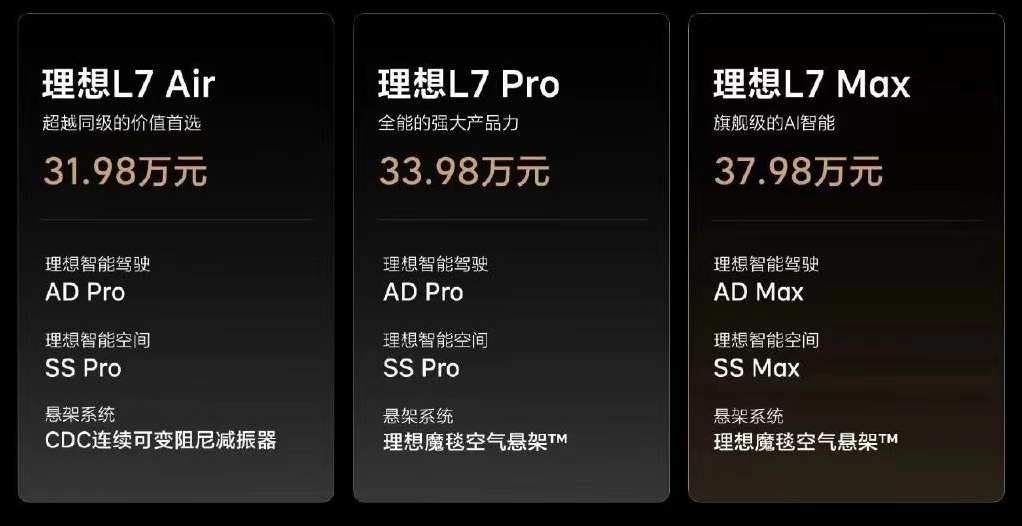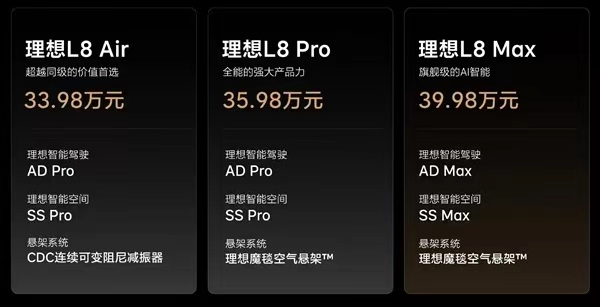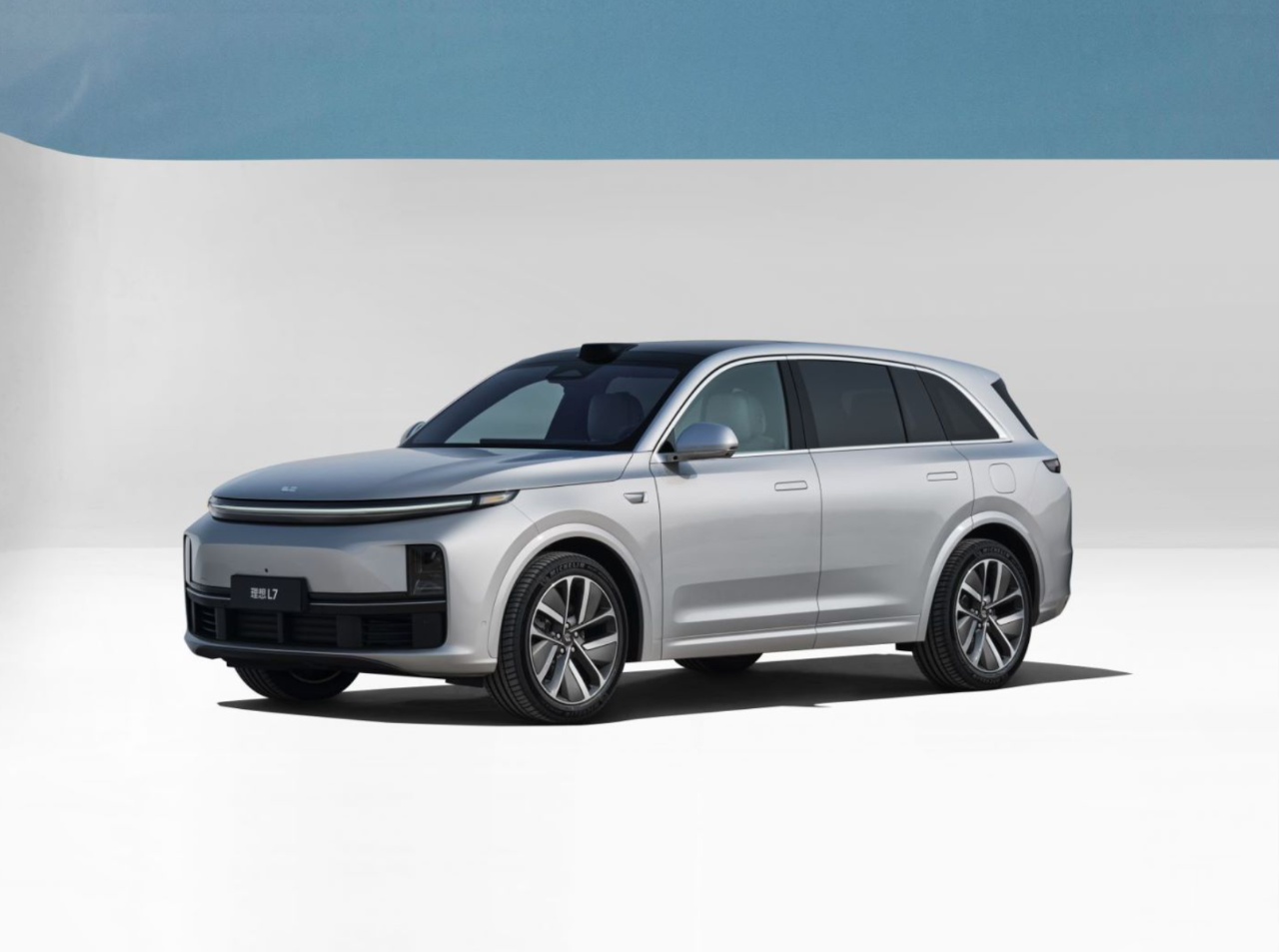Author: Zheng Senhong
An Apple-style product launch, Ideals penetrate the 5-seater SUV market.
On February 8th, Ideals’ first 5-seater SUV model L7 was officially released. In addition to the previously announced Pro and Max versions, Ideal also brought a “stripped-down” version.

-
L7 Air is priced at 319,800 yuan, without air suspension, without LIDAR, without rear screen, equipped with Horizon Journey 5 chipset, battery supplier is BAK, to be delivered in April.
-
L7 Pro is priced at 359,800 yuan, with air suspension, without LIDAR, without rear screen, equipped with Horizon Journey 5 chipset, to be delivered in March.
-
L7 Max is priced at 379,800 yuan, with air suspension, with LIDAR, with rear screen, equipped with two NVIDIA Orin-X chipsets, to be delivered in March.

In addition, Ideal L8 also added an Air model, priced at 339,800 yuan. Compared with the Pro version, the Air version also reduces the air suspension configuration, and the battery is replaced by Xinwangda, to be delivered in April.
The change in batteries means that Ideal’s battery suppliers have changed from Ningde Times to three companies including Ningde Times, Xinwangda, and BAK.
In terms of product, Ideals L7, L9, and L8 are almost the same in terms of design and configuration, but the biggest difference of L7 is that it is a 5-seater model, which is also the biggest selling point of L7.
If Ideals’ previous hit cases were based on six seats and extended mileage to open up the blank market, this time it is undoubtedly a head-on competition with the medium and large SUV market.## Pressuring BBA, Cost-Effectiveness is the Keyword
Before the launch event, the Ideal L7 was no longer a mysterious model.
Since its first appearance as “One more thing” at the L8 launch event in late September 2022, Ideal has already announced the price and partial parameters of the L7, and opened reservations.
Visually, it is difficult to distinguish between the three models of Ideal L7/8/9, and in Ideal’s setting:
- L9 is a super large cup for “three generations travelling frequently”;
- L8 is a large cup for “two generations travelling frequently + occasional three generations travel”;
- L7 targets the “family of three” and is a medium cup.
It can be seen that Ideal L7 is in a sub-segment of the 5-seat SUV market that is larger than L9 and L8, and it is also a competitive market that competes with NIO ES7, XPeng G9, and Mercedes GLC, BMW X3, and Audi Q5L at the same price.
As a new entrant, where are the advantages of the Ideal L7?
Within Ideal Auto, they adhere to a product value formula – Product value = Product strength/Product price.
According to Zhang Xiao, the person in charge of Ideal Auto’s product planning, providing products with crushing strength at the same price point becomes the first choice in this price range, which is the source of Ideal’s confidence.
Looking at the three products in the Ideal L series, the way to achieve high cost-effectiveness is through fully-featured hardware and software standardization.
In the price range of 300,000 RMB, Ideal L7 has achieved a cost-effective advantage of “unavailable in the same price range, optional at 500,000 RMB, standard on million-dollar luxury cars”.## Interior configuration first
The Ideal L7 full vehicle is wrapped in NAPPA leather, and both the front and rear seats have heating, ventilation, and massage. It also comes equipped with independently adjustable rear B pillar air conditioning and 21/19 speakers with a total power of 1920w, allowing for features such as game room, private cinema, and KTV room, all of which are standard on the L7.
In comparison, these configurations are optional items for traditional luxury BBA brands at the same price point.
Power consumption aspect secondly
The L7 is equipped with the second-generation 1.5T 4-cylinder turbocharging system and a 42.8-degree battery pack. The CLTC pure electric cruising range is 210 kilometers, and the comprehensive cruising range is 1315 kilometers with a lowest average fuel consumption of 5.88L/100km.
During the performance aspect, Ideal didn’t overlook its luxury brand competitors, beating the Porsche Cayenne, Mercedes-Benz GLE, and BMW X5L.
According to official figures, if someone drives 20,000 kilometers per year and 90% of it is pure electric, then the annual energy cost of the vehicle is only 2800 yuan, which saves up to 12,000 yuan compared to some other traditional luxury brands of large SUVs.
Lastly, regarding the intelligence of the car, Ideal has made new progress in voice and gesture interactions.
For example, based on deep neural networks, the MIMO-NET algorithm of Ideal achieves accurate separation of multi-tone human voices, and the voice recognition accuracy in complex real scenarios with multiple people speaking has improved by more than 42% compared with half a year ago. In terms of vision, the overall success rate of gesture interaction has increased by more than 50%.
In short, following the selling point of the Ideal L Series, the L7 features luxury, intelligence, performance, and safety.
At this launch event, the Ideal L7 repeatedly placed traditional luxury vehicles such as the BMW X5L, Mercedes-Benz GLE, and Audi Q7 in the competitive system, with the BMW X5L’s presence in terms of space, configuration, power, and endurance. However, the price is the same as the X3 and Q5L.
It can be said that Ideal has grasped the Chinese consumer’s pursuit of extreme cost performance and face-saving psychology.
In fact, after the Ideal L9 met market expectations, the same design and configuration applied to cheaper models undoubtedly improved the product’s cost performance. The Ideal L7 is no exception.
This is also why Ideal’s products always give people a feeling of “without rivals at the same level.”
With the increase of the range of six-seat blank cars, gradually covering all price and function segments of the SUV product line, offsetting the traditional fuel vehicles, and occupying the entire 200,000-500,000 yuan range of the home SUV market in reverse competition in the pure electric field when the electric exchange and charging are mature.
This is Li Xiang’s clear product line, and the core keywords among them are “extended-range” and “six-seat”.
From the perspective of market share, the Ideal has become the benchmark product in the family luxury electric car market.
According to statistical data, in 2022, the Ideal will have a market share of 56.9% in the new energy SUV market (Ideal ONE, Ideal L8) in the C-class, and an 81.5% market share in the new energy SUV market (Ideal L9) in the D-class.
In January 2023, Li Xiang announced “four firsts” in December 2022 on an internal memo:
- Sales of SUVs priced between 300,000 and 500,000 yuan will be the first
- New energy vehicle sales of SUVs priced between 300,000 and 500,000 yuan will be the first
- Large SUV sales will be the first
- Mid to large SUV sales will be the first
After the Ideal L9 and L8 won championships in their respective segmented markets, Li Xiang’s ambition turned to the more extensive 5-seat SUV market.In the Chinese automobile market, there are a total of 16 family-oriented SUV and MPV models (excluding commercial models such as the GL8 and off-road SUVs such as the Jeep Wrangler) with 6-7 seats and prices between 300,000-400,000 RMB, including the still available Ideal ONE. If 5-seaters are also considered, there are a total of 30 models.
It can be seen that both the model availability and sales in this market are in a rapid growth stage.
In terms of competing models, BBA can maintain monthly sales of over 10,000 units in this segment, making it the biggest competitor to Ideal L7 but also presenting the biggest opportunity for L7.
Li Xiang is an extreme “Internet car manufacturer” ideologist, who hasn’t defined “what makes a good car” according to traditional automobile standards or discourses, from the earliest Ideal ONE to the current Ideal L7, instead defining a “good product” from the perspective of the internet.
With clear positioning and concise concepts, Li Xiang’s car-making logic is to “gamble” on users’ preferences.
In Li Xiang’s view, precisely targeting the family as the best user group, constructing a full-chain operation capability that interconnects every link, surpassing user needs, and creating the best products and services are the fundamental reasons why Ideal L9, L8, and L7 have been successful in their respective classes after Ideal ONE became the sales champion.
In other words, describing Ideal’s product layout as “precise knife-work” is most appropriate.
According to Sun Shaojun, founder of Car Fans, as of the day before the launch of the Ideal L7, the model had already received more than 20,000 orders.
With Ideal L7’s launch, Ideal has now formed a product portfolio consisting of three new models: L9, L8, and L7, with a total market reach of approximately 1.2 million (SUV market of 300,000-500,000 RMB). And with an annual sales target of 30,000 for Ideal, L7 is undoubtedly the model that allows Ideal to support its own family financially.“`
For Li Xiang, the success in 2023 is crucial, which will lay the foundation for the long-term development of the ideal in the smart electric car track.
One More thing: The first to create the city NOA navigation-assisted driving, and NOA urban driving will be released by the end of the year.
In January 2023, Li Xiang and He XPeng announced the plan for “city-level autonomous driving” in 2023 successively.
He XPeng said that in 2023, the full automatic driving will be launched first in China, and it can be implemented in more than 50 cities in China. Li Xiang plans to start landing “city NOA navigation-assisted driving” at the end of 2023.
At the Ideal L8 conference last year, the ideal took into account the safety bottom line and safety upper limit, improved the perception ability around the BEV algorithm, proposed a 3D hypothesis and a 2D confirmation dimensionality reduction solution, and completed the front fusion BEV algorithm of multiple sensors such as lidar and cameras.
At the Ideal L7 conference, the ideal first showed the latest test video of “city navigation-assisted driving”.
The road test video mainly presents two highlights: one is the ideal L7 realizing unprotected left turn on urban roads, and the other is the urban perception ability based on the mixed BEV network model released by Ideal.
Lang Xianpeng said that the real-time road structure cognitive algorithm of the ideal city NOA based on HDMapNet will perceive and make decisions based on the surrounding environment in real-time like human beings, and get rid of excessive dependence on high-precision maps to achieve the rapid expansion of city NOA and the future trend of fully autonomous driving.
The “heavy perception, light map” solution can be said to be a popular technological route in the smart driving industry, and XPeng, Hao Mo Zhixing, and others are evolving towards the direction of “going to high-precision maps”.
According to the plan, the ideal will release the city NOA internal test to AD Max users in the fourth quarter of 2023.
In 2021, Andrej Karpathy, the person in charge of Tesla’s autonomous driving technology, publicly announced the algorithm used in the FSD autonomous driving system at AI Day, and Transformer is one of the core modules, which brings obvious capabilities to Tesla FSD. The ideal is no exception.
“““
Ideal’s head of intelligent driving, Lang Xianpeng, said that the hybrid BEV algorithm framework used by Ideahas the capability to use pure visual sensors for AD Pro, and can also be compatible with other sensors such as Lidar for AD Max.
In terms of data, the Ideal BVE algorithm network has a depth of 30,000 layers and a network parameter of 2.8 billion.
The most intuitive result is that AD Max can handle various complex vehicle merging scenarios more comfortably, and the autonomous lane change success rate for high-speed NOA reaches *98\%.
At the self-developed algorithm level, Ideal has achieved two industry firsts.
One is based on the verification of the multi-obstacle interaction prediction model. Ideal has pioneered a Lane Keeping Assist Plus – LKA Plus, which is an enhanced version of the lane keeping assist that can autonomously overtake without using high-speed NOA.

The second is that the Ideal’s self-developed AEB algorithm has added the application of Lidar on AD Max, making it the first in the industry to integrate Lidar with the AEB function.
Simply put, Ideal is expanding the safety scenarios of Lidar algorithms from main traffic participants such as vehicles, cyclists, and pedestrians to include irregular obstacles and night scenes, including crosswalks at night without ambient lighting, and the vehicle can completely stop at a speed of 60 kilometers per hour.
As of now, Ideal’s intelligent driving total mileage has exceeded 510 million kilometers, of which the high-speed NOA navigation-assisted driving mileage has reached 87.89 million kilometers.
In Li Xiang’s view, the software 1.0 stage is the stage where humans design the logic, program the machine, and use the software, while the software 2.0 stage is the stage where the machine learn from humans (including perception, decision, execution, and feedback), cloud-based training algorithms, and machines serving humans.
“`
He believes that the landing of software 2.0 technology products will officially start in China, and smart driving will be an important application in the software 2.0 stage.
Starting from the second half of 2022, urban NOA will become a must-have for automakers.
Car companies such as BAIC EXALT, XPeng, and Great Wall have successively launched products with urban NOA functions, but different companies and different technical routes have greatly different production and delivery progress in urban NOA.
Today, Ideal, based on the popular BEV perception and Transformer model in the industry, will implement urban NOA without high-precision maps, but the final answer still needs time verification.
On the other hand, Ideal should also try its best to improve the brand’s profit space and form a healthy self-generation ability in terms of intelligence. Li Bin and He XPeng have successively set the profit time in 2024 and 2025.
For Ideal, who has entered the era of family-style products, it’s time to say goodbye to seven consecutive years of loss-making operation.
This article is a translation by ChatGPT of a Chinese report from 42HOW. If you have any questions about it, please email bd@42how.com.
